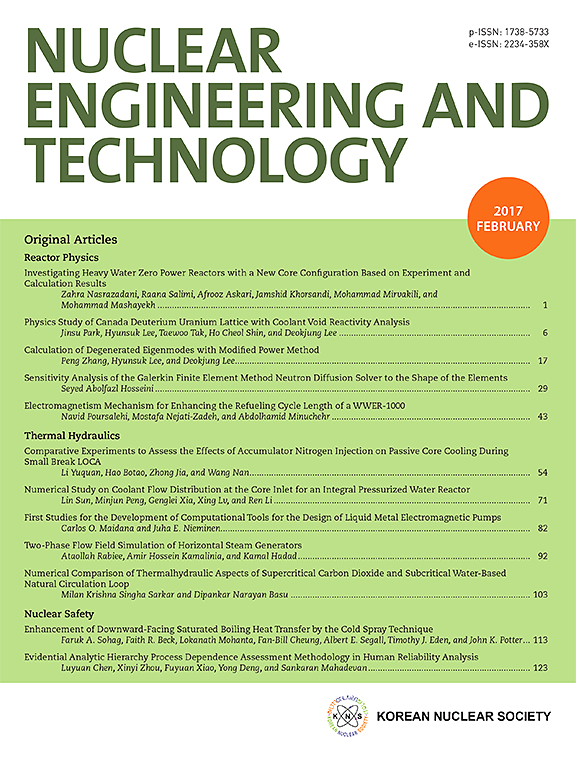Performance analysis of a two-step calculation procedure based on Monte Carlo and pin-wise diffusion methods for PWR core design
IF 2.6
3区 工程技术
Q1 NUCLEAR SCIENCE & TECHNOLOGY
引用次数: 0
Abstract
This study introduces an efficient two-step calculation procedure for PWR core design by integrating Monte Carlo and pin-wise diffusion methods. The methodology combines Monte Carlo's high-fidelity cross-section generation with pin-wise diffusion's computational efficiency to model neutron flux and power distribution in reactor cores. The approach incorporates Super Homogenization (SPH) factors to enhance neutron flux heterogeneity modeling, addressing the complexities of modern reactor designs with advanced burnable absorbers and control rod strategies.
Verification using the APR1400 benchmark demonstrates accuracy comparable to whole-core transport codes while maintaining computational efficiency. The methodology is also applied to innovative Small Modular Reactors (i-SMR), particularly evaluating cores with advanced fuel management and soluble boron-free operations. Results show accurate predictions of neutron flux and power distributions in i-SMR cores incorporating advanced burnable absorbers like HIGA (Highly Intensive and Discrete Gadolinium/Alumina Burnable Absorber). The approach effectively addresses i-SMR-specific challenges, including maintaining reactor criticality during extended operational periods. Through optimized parallelization, 3D reactor calculations are completed within seconds, ensuring practical applicability in various operational scenarios.
This methodology represents a significant advancement in reactor core analysis, offering a high-precision, computationally efficient solution for modern PWR and i-SMR core designs, while maintaining exceptional accuracy in predicting core physics parameters.
压水堆堆芯设计中基于蒙特卡罗和引脚扩散两步计算方法的性能分析
本文介绍了一种利用蒙特卡罗法和针向扩散法进行堆芯设计的两步计算方法。该方法结合蒙特卡罗的高保真截面生成和针向扩散的计算效率来模拟反应堆堆芯中的中子通量和功率分布。该方法结合了超均质化(SPH)因素来增强中子通量非均质化建模,通过先进的可燃吸收剂和控制棒策略解决了现代反应堆设计的复杂性。使用APR1400基准的验证证明,在保持计算效率的同时,准确性可与全核传输代码相媲美。该方法也适用于创新的小型模块化反应堆(i-SMR),特别是评估具有先进燃料管理和可溶无硼操作的堆芯。结果表明,采用HIGA(高强度和离散钆/氧化铝可燃吸收剂)等先进可燃吸收剂的i-SMR堆芯可以准确预测中子通量和功率分布。该方法有效地解决了i- smr特有的挑战,包括在延长的运行期间保持反应堆临界状态。通过优化的并行化,3D反应堆计算在数秒内完成,保证了各种操作场景的实用性。该方法代表了反应堆堆芯分析的重大进步,为现代压水堆和i-SMR堆芯设计提供了高精度、计算效率高的解决方案,同时在预测堆芯物理参数方面保持了卓越的准确性。
本文章由计算机程序翻译,如有差异,请以英文原文为准。
求助全文
约1分钟内获得全文
求助全文
来源期刊

Nuclear Engineering and Technology
工程技术-核科学技术
CiteScore
4.80
自引率
7.40%
发文量
431
审稿时长
3.5 months
期刊介绍:
Nuclear Engineering and Technology (NET), an international journal of the Korean Nuclear Society (KNS), publishes peer-reviewed papers on original research, ideas and developments in all areas of the field of nuclear science and technology. NET bimonthly publishes original articles, reviews, and technical notes. The journal is listed in the Science Citation Index Expanded (SCIE) of Thomson Reuters.
NET covers all fields for peaceful utilization of nuclear energy and radiation as follows:
1) Reactor Physics
2) Thermal Hydraulics
3) Nuclear Safety
4) Nuclear I&C
5) Nuclear Physics, Fusion, and Laser Technology
6) Nuclear Fuel Cycle and Radioactive Waste Management
7) Nuclear Fuel and Reactor Materials
8) Radiation Application
9) Radiation Protection
10) Nuclear Structural Analysis and Plant Management & Maintenance
11) Nuclear Policy, Economics, and Human Resource Development
 求助内容:
求助内容: 应助结果提醒方式:
应助结果提醒方式:


